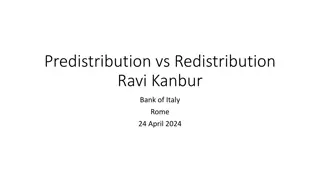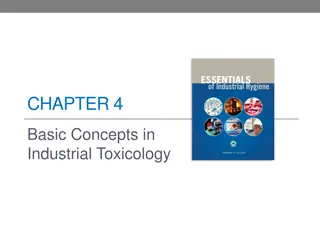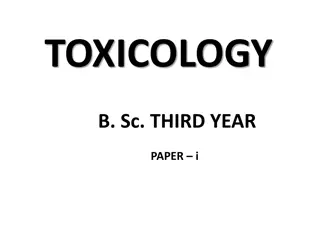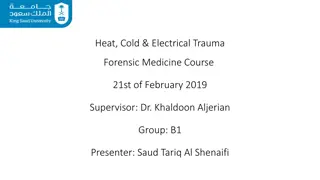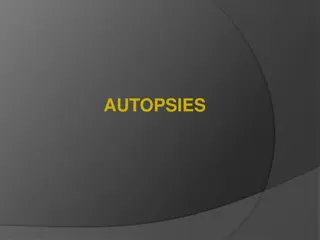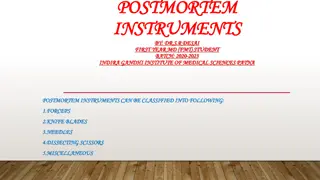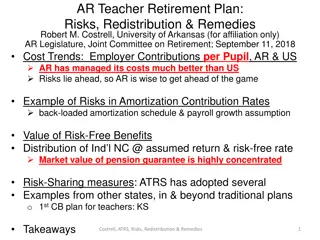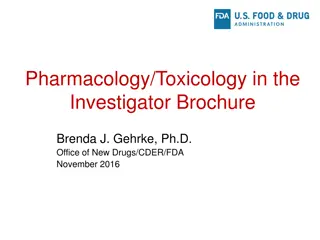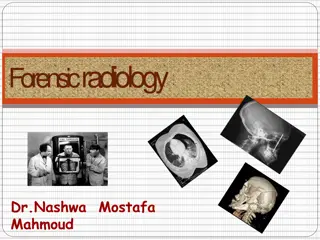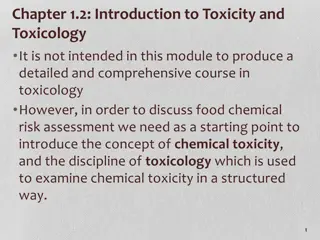Understanding Postmortem Redistribution in Forensic Toxicology
Postmortem Redistribution (PMR) refers to the variation in drug concentrations obtained from postmortem samples, which may not accurately reflect the levels at the time of death due to redistribution mechanisms. In forensic toxicology, assessing drug severity relies on blood concentrations, with challenges in evaluating total drug intake postmortem. Various organs play a role in drug redistribution after death, impacting toxicological analysis and interpretation.
- Postmortem Redistribution
- Forensic Toxicology
- Drug Concentrations
- Postmortem Sampling
- Pharmacokinetics
Download Presentation

Please find below an Image/Link to download the presentation.
The content on the website is provided AS IS for your information and personal use only. It may not be sold, licensed, or shared on other websites without obtaining consent from the author. Download presentation by click this link. If you encounter any issues during the download, it is possible that the publisher has removed the file from their server.
E N D
Presentation Transcript
Postmortem Redistribution (PMR) The variation in the concentrations of drug obtained from postmortem (a medical examination of a dead person's body in order to find out the cause of death:) samples do not necessarily reflect the blood concentrations at the time of death due to variations in these concentrations according to the sampling site and the interval between death and sampling.
Postmortem Redistribution (PMR) In forensic toxicology (with reference to drugs), the severity or lethality of a detected drug is generally esteemed in the light of the blood concentration of that drug for which reference values such as therapeutic, toxic, or lethal levels often exist. Although, in the living, blood concentrations may allow evaluation of the total amount administered (e.g., following a single administration), taking pharmacokinetic characteristics of the given molecule, this evaluation is generally not possible in the postmortem period. into account the
Many drugs are isolated antemortem (before death) in organs qualified as drug reservoirs . After death, drugs are redistributed to the surrounding tissues or hollow organs, such as different parts of the gastrointestinal tract, or viscera etc. PMR mechanisms: from these organs can occur by two different (i) Diffusion through blood vessels and (ii) Trans-parietal organs. diffusion towards the surrounding
Sources of Postmortem Redistribution Mechanism for PMR Mechanism Consequences Redistribution to surrounding tissues Cardiac chambers, thoracic vessels, left lung, liver, inferior vena cava Cardiac chambers, thoracic vessels, liver Heart blood Inferior vena cava, right cardiac chambers, pulmonary / vessels, stomach, duodenum, gall bladder Drug Reservoirs Gastrointestinal tract Lungs Myocardium Liver Cadaveric changes Cell death Blood coagulation and hypostasis Blood movements Putrefactive process (bacteria) Drug chemical and Pharmacokinetic properties Acidic / basic Properties Lipophilicity Drug binding proteins or red cells High volume of distribution (Vd) Residual metabolic activity Leakage of drug into the extracellular space Modification of serum / blood ratio Transport of xenobiotics and mixing of bloods from different origins Degradation and / or synthesis of macromolecules ? ? ? Leakage from tissues ?
Redistribution from the gastrointestinal tract Unabsorbed drugs in the stomach at the time of death can be redistributed to mediastinal vessels and surrounding organs Passive diffusion from the gastric content into surrounding organs mainly concerns the lower lobe of the left lung, the left posterior margin of the liver, and to a lesser extent the caudate lobe and--when the corpse is in a supine position--the posterior part of the right lobe The pericardial fluid and the myocardium are also affected by redistribution from the stomach, and it is likely that the close anatomical apposition of the fundus against the diaphragm is a determinant factor. PMR concerns the whole upper gastrointestinal tract and not only the stomach. Moreover, it is influenced by physical factors such as drug concentration in the gastrointestinal content, the volume of this content, the temperature of the corpse, and time between death and sampling. it is slowed by refrigeration at 4~ and increases with the delay between death and autopsy. Pre-existing pathological conditions may influence PMR.
Redistribution from the lungs PMR from the lungs begins within the first two hours after death, inducing a rise in drug concentrations in cardiac chambers and thoracic vessels and is more intense than redistribution from the gastrointestinal tract. the concentrations in the aorta and left cardiac chambers are higher than in the superior vena cava and right cardiac chamber. Redistributed via the pulmonary vessels. The intensity of the redistribution from lungs could be explained by the large surface area of the alveoli, the thin diffusion membrane, and the high vascularization. This redistribution may coexist with redistribution from the gastrointestinal tract, and it could be very difficult to determine the main mechanism when drugs were taken orally.
Redistribution from the liver PMR from the liver is complex, as it involves different mechanisms. Drugs retained in the liver at the time of death could be redistributed via the hepatic veins to the inferior vena cava and then into the right cardiac chambers and pulmonary vessels or to peripheral venous blood. One of the results of this redistribution is the decrease in drug concentrations in hepatic lobes but this process is not as intense and early as redistribution from the lungs. Secondly, drugs could be redistributed directly into adjacent organs. The anatomical relationships of the human liver that are relevant to PMR are with the stomach, the pylorus, the proximal duodenum, and the gall bladder, but this is not as important as the redistribution via the hepatic vessels.
Redistribution from the myocardium In the living, many cardiac drugs are concentrated in the myocardium. E.g. Digoxin, calcium channel blockers and quinidine, but drugs are rapidly redistributed into cardiac blood, in which concentrations rise dramatically. A moderate increase has also often been described in the subclavian venous blood, which cannot, for this reason, be considered as a peripheral blood specimen. Such redistribution from the myocardium into heart blood has also been described for other drugs such methamphetamine; propoxyphene and norpropoxyphene; imipramine and desipramine; and amitriptyline, doxepin, maprotiline, and metoprolol. Concentration increase observed in cardiac blood may result from redistribution from the stomach, lungs, or liver, proof of redistribution from the myocardium as the primary mechanism responsible for this increase would be demonstrated by higher concentrations of the drug in both the left and right cardiac chambers. as morphine; amphetamine;
Redistribution into body fat Some very highly lipophilic drugs are concentrated in adipose tissues by simple physical dissolution in neutral fats. This distribution occurs slowly, as the blood flow to adipose tissues is low and the equilibrium between blood and adipose tissue concentrations may not have been achieved at the time of death. In such a case, a continued distribution (rather than a real redistribution) of these drugs from blood into adipose tissues, lowering the postmortem blood concentrations, can occur. This phenomenon occurs for anesthetics and volatile compounds.
Pharmacokinetics of Drugs PMR process may be influenced by the pharmacokinetic behavior of drugs. PMR of drugs depends not only on changes in cells and tissues during and after death, but also on the pharmacokinetic properties of these drugs. The postmortem changes in pharmacokinetics are more complex, and modifications may occur at each pharmacokinetic stage, that is, absorption, distribution, metabolism, and elimination.
Absorption & Redistribution Most drugs cross membranes by passive diffusion, depending on the concentration gradient of the molecule and the pH on both sides of the membrane; molecular size, lipid solubility, and the ionization state of the molecule. The PMR of a drug cannot be predicted only by its lipophilic properties and its apparent Vd. Other factors such as the absorption route, dose, or particular affinity of the drug for some tissues must be envisaged as well as the possibility of a residual metabolic activity in the first hours after death.
Practical consequences in forensic toxicology Blood samples must be taken at central (cardiac) and peripheral sites. In the framework of postmortem drug redistribution studies, cardiac blood samples must be taken from the right and left cardiac chambers separately, in order to determine the PMR mechanism. In the framework of postmortem drug redistribution studies, cardiac blood samples must be taken from the right and left cardiac chambers separately, in order to determine the PMR mechanism. Ideally, the right lobe of the liver, the right kidney, and the right lung should be sampled left lung, because the left kidney and the left lobe of the liver are more prone to PMR because of redistribution from the gastrointestinal tract.
Practical consequences in forensic toxicology The skeletal muscle has been suggested as an alternative specimen for postmortem toxicology because it is present in large amounts and is affected by decomposition later than blood or viscera muscle samples can be obtained from peripheral sites, far from drug reservoirs such as the stomach, liver, and lungs Finally, the hematic fluid found in the declive pleural spaces is the worst biological medium for the quantitation of drugs because it is a mixture of blood and serous fluid from lungs and other thoracic organs, or even the stomach.
Practical consequences in forensic toxicology PMR of drugs may complicate the interpretation of the results in forensic toxicology. The competing processes of diffusion from drug reservoirs, cell lysis and putrefaction, and the particular pharmacokinetic properties of certain drugs contribute to the differences in drug concentrations observed between sites and sampling intervals. The most common problem is a difference in drug concentration between the different sampling sites. If these differences are moderate and especially if all these site concentrations are in the same range, i.e. therapeutic, toxic, or fatal, the interpretation may not be an issue. However, interpretation is more difficult when these concentrations are very discordant.
Practical consequences in forensic toxicology The pharmacokinetics of the drugs concerned must be taken into account, as well as, if possible, the autopsy findings, which in many cases give useful information. The position of the corpse and regurgitation of the gastric contents into the airways or thoracic trauma may, for example, explain differences in blood concentrations from different sampling sites. Sampling sites, postmortem delay, or autopsy conditions are very important because a large number of toxic drugs are lipophilic weak bases with a large Vd, prone to PMR.




